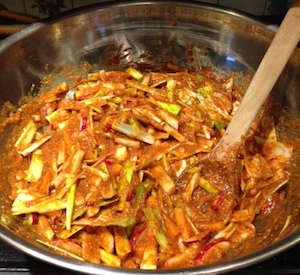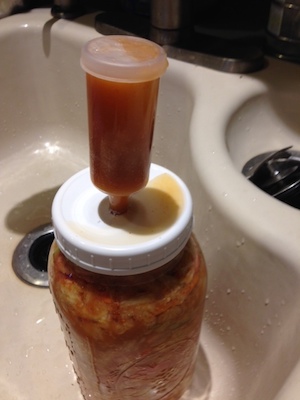Most weeks, when it’s time to write my blog, inspiration hits while I’m sitting in front of the blank screen. This week, inspiration was served to me in a huge, smelly bucket.
The more we slide down the slippery slope into full-fledged hippy-dom, the more we find ourselves baking, cooking, preserving and now, fermenting, healthful foods. There is a tremendous amount of good stuff in fermented foods. Fermentation in food processing, according to wikipedia.com is:
“The conversion of carbohydrates to alcohols and carbon dioxide or organic acids using yeasts, bacteria, or a combination thereof, under anaerobic conditions. Fermentation usually implies that the action of microorganisms is desirable. The science of fermentation is also known as zymology or zymurgy.”
The term “fermentation” is sometimes used to specifically refer to the chemical conversion of sugars into ethanol, a process which is used to produce alcoholic beverages such as wine, beer, and cider. Fermentation is also employed in the leavening of bread (CO2 produced by yeast activity); in preservation techniques to produce lactic acid in sour foods such as sauerkraut, dry sausages, kimchi, and yogurt; and in pickling of foods with vinegar (acetic acid).
We focus mostly on the sour foods. The process creates a living food, loaded with probiotics. Studies have shown that probiotics are excellent for improving gut health, which can be linked to improved overall health. Needless to say, I’m a fan of all of this and have enjoyed our past fermenting experiences.
Usually, there’s not a lot to it. The hardest part is the waiting. Fermenting takes time and patience.
 Unless, apparently, you’re making kimchi, a fermented Korean cabbage dish. Then, it’s a God-forsaken nightmare of ridiculous food-prepping, giant messes, horrible smells and burning lungs.
Unless, apparently, you’re making kimchi, a fermented Korean cabbage dish. Then, it’s a God-forsaken nightmare of ridiculous food-prepping, giant messes, horrible smells and burning lungs.
My husband is a huge fan of spicy food. He had great success with fermented radishes, but they lost all their natural kick as the process went on. In the end, we had a delicious, salty food that I ate as often as I could. I would have gladly made this same recipe again. However, ever the adventurous eater, the man I married, decided to go bigger.
No more easy, clean radishes and salt in a glass jar. Nope. “I’ve always wanted to try kimchi,” he said. He actually said it a lot, over the course of many months. Initially, I agreed. Nearly all of our fermenting experiences had been great successes. Why not kimchi?
The more he researched it, the less interest I had. But, I’m a huge fan of sauerkraut and my brilliant counterpart saw this as the in, “It’s just a spicy sauerkraut.” Lies. A big, fat pack of fish-saucy fibs that took over my kitchen and plagued my week like a giant cold sore of Korean misery.
So last Sunday, as the day was winding down and I was preparing to get in the kitchen and do all my prep for the week, the yin to my yang marched in with a seven and a half pound cabbage, a 10-gallon bucket and an instructional video where the main star eats raw squid (don’t ask — seriously, don’t). For the next two hours, I chopped, cleaned dishes, peeled, cleaned dishes, seethed with anger and cleaned dishes, all to the lovely background noise of a heavy Korean accent, gleefully extolling the praises of the wonderful smell of 10 pounds of cabbage mixed with paste, two cups of ground, crushed red pepper and a large volume of fish sauce. She and I disagree on this issue.
When it was all over, and the kitchen was clean and I had come to terms with the loss of my weekly prep, I felt a little calmer. I even wondered if perhaps I hadn’t been too harsh. After all, he was trying to make something that was healthful. He was trying to contribute to our food stock. And even though two cups of ground cayenne pretty much guaranteed he would be the only one eating it, at least he was chipping in.
I quickly got over this emotion when he asked if he could put the bucket on my dining room buffet. Instead of responding, I believe I turned several shades of purple, steam shot out my ears and horns sprouted from my head. The bucket has since found a lovely home in the basement. But somehow, a mason jar of this abomination found its way onto my fireplace mantle.
 It was this mistake that assured that kimchi will never, ever, ever, be made in this house again. You see, on my one day off, while I was running around, trying to get 24 hours worth of long over-due chores done in seven hours time, I noticed an odd and unpleasant smell. It took very little time for me to find the source and discover that the kimchi was indeed actively fermenting. It was fermenting so much, that it had flowed out of its jar and formed an orange-colored, dead-fish smelling pool that was threatening to drip onto the top of the wood burning stove.
It was this mistake that assured that kimchi will never, ever, ever, be made in this house again. You see, on my one day off, while I was running around, trying to get 24 hours worth of long over-due chores done in seven hours time, I noticed an odd and unpleasant smell. It took very little time for me to find the source and discover that the kimchi was indeed actively fermenting. It was fermenting so much, that it had flowed out of its jar and formed an orange-colored, dead-fish smelling pool that was threatening to drip onto the top of the wood burning stove.
As I stopped what I was doing to quickly clean and disinfect, I took the time out to send my husband a picture with a message that read something like, “You’re a dead man,” except with a few curses inserted. I continued to barrage him with threats and foul language, finishing with the promise that upon his arrival home that evening, he would find his precious kimchi either in the garage, or at the bottom of our chickens food dish. I plan to never speak of the great kimchi incident of 2014 ever again.
If you were thinking I would give you the link to the kimchi-making video, you were very, very wrong. I would never subject any other person to the horror. If you are hellbent on making some, good luck. I wish you well. But I don’t want to hear it when you come to the painful realization that fish sauce is, “liquid extracted from the fermentation of fish with sea salt.” And that it smells just like that.
Instead, I will give you a recipe for a homemade air freshener. This way, if you ignore my warnings, those who live with you will have some recourse.
There are lots of easy and effective options for making your own air freshener. They all take a matter of seconds to make and cost pennies.
Home-made air freshener
Ingredients
Spray bottle
1/2 cup water
5-10 drops of your favorite essential oil (I often combine a couple. My favorite is lavender and vanilla)
optional ingredients:
1 tbsp. of baking soda
Pour water into the spray bottle. Add the essential oil. Shake. Spray liberally.
If you’d like to add the baking soda, mix with the essential oils prior to putting in the spray bottle. Then add the water to the bottle with the soda/oil mix. Shake. Spray liberally.
Have you ever had a Sunday where you weren’t sure your husband would survive to see Monday? I’d love to hear all about it…laurie@riverheadlocal.com.
The survival of local journalism depends on your support.
We are a small family-owned operation. You rely on us to stay informed, and we depend on you to make our work possible. Just a few dollars can help us continue to bring this important service to our community.
Support RiverheadLOCAL today.































